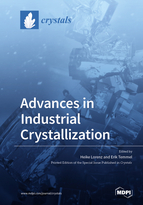Advances in Industrial Crystallization
A special issue of Crystals (ISSN 2073-4352). This special issue belongs to the section "Industrial Crystallization".
Deadline for manuscript submissions: closed (30 June 2020) | Viewed by 61591
Special Issue Editors
Interests: phase equilibria; crystallization kinetics; process monitoring & design; separation of fine chemicals, large scale industrial products and renewable resources; innovative crystallization-based separation concepts; enantiomers; natural products; multi-component mixtures
Special Issues, Collections and Topics in MDPI journals
Interests: phase equilibria; crystallization kinetics; continuous crystallization; process monitoring; process design; applied population balance and process modelling; process intensification and combination; process optimization; novel measurement techniques
Special Issue Information
Dear Colleagues,
Crystallization is a key technology utilized in many industries for the manufacture of bulk and fine chemicals, such as agrochemicals, pharmaceutical ingredients and food components. There, the objectives of applying crystallization processes are usually twofold: separation and purification of substances on the one hand and, targeted product design on the other hand. The latter refers to the generation of product particles of desired properties, as purity, a particular solid-state form, crystal size (distribution) or morphology. Process-related target variables include, amongst others, yield, productivity, robustness and costs. The overall process, thus, has to fulfill multiple tasks at same time.
According to the industrial importance and wide application field of crystallization, active research is performed on a broad range of subjects covering fundamentals (e.g. phase equilibria, kinetics and crystallography), analytical tools for crystallization monitoring, separation process design and optimization, product development and, addresses integrated process chains and sustainability issues as well. Considering these variety of potential topics, the scope of this Special Issue on “Advances in Industrial Crystallization” is intentionally broad. We invite interdisciplinary contributions concerning both, understanding crystallization processes and crystallization behavior of compounds, and their applications in commodities and fine chemicals industries and sustainability fields.
Some keywords are given as a guide for submissions to this Special Issue, but research papers dealing with other innovative findings in industrial crystallization are also welcome.
Prof. Heike Lorenz
Dr. Erik Temmel
Guest Editors
Manuscript Submission Information
Manuscripts should be submitted online at www.mdpi.com by registering and logging in to this website. Once you are registered, click here to go to the submission form. Manuscripts can be submitted until the deadline. All submissions that pass pre-check are peer-reviewed. Accepted papers will be published continuously in the journal (as soon as accepted) and will be listed together on the special issue website. Research articles, review articles as well as short communications are invited. For planned papers, a title and short abstract (about 100 words) can be sent to the Editorial Office for announcement on this website.
Submitted manuscripts should not have been published previously, nor be under consideration for publication elsewhere (except conference proceedings papers). All manuscripts are thoroughly refereed through a single-blind peer-review process. A guide for authors and other relevant information for submission of manuscripts is available on the Instructions for Authors page. Crystals is an international peer-reviewed open access monthly journal published by MDPI.
Please visit the Instructions for Authors page before submitting a manuscript. The Article Processing Charge (APC) for publication in this open access journal is 2600 CHF (Swiss Francs). Submitted papers should be well formatted and use good English. Authors may use MDPI's English editing service prior to publication or during author revisions.
Keywords
- Phase equilibria
- Measurement of crystallization kinetics
- Crystallization process monitoring
- Advances in process and product design
- Industrial applications
- Separation of complex mixtures
- Innovative crystallization process concepts and combinations
Related Special Issue
- Recent Progress in Industrial Crystallization in Crystals (13 articles)







